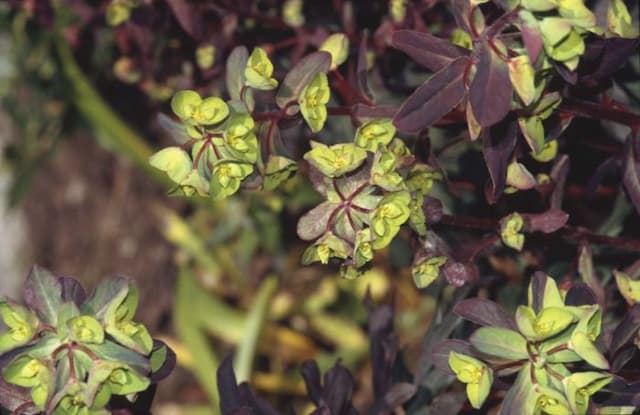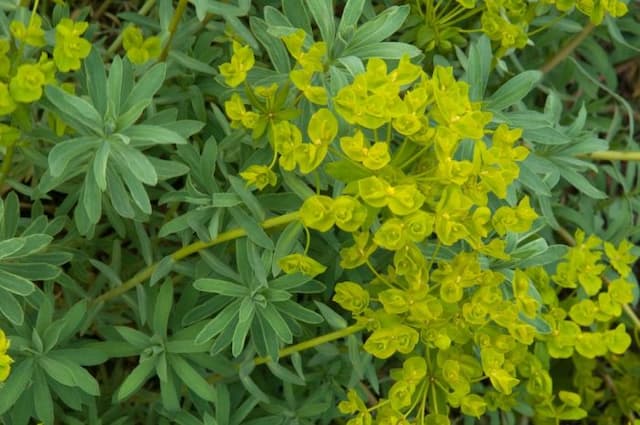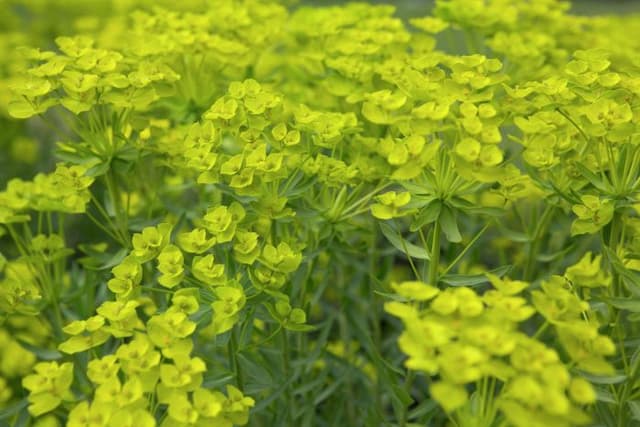Mediterranean Spurge Euphorbia characias 'Tasmanian Tiger' (PBR) (v)

ABOUT
Euphorbia characias 'Tasmanian Tiger' is a striking ornamental plant known for its bold and distinctive variegation. This spurge variety features leaves that are long and narrow with a creamy-white border that contrasts sharply with the blue-green central portion. The variegation patterns on the leaves add a stunning visual texture to the foliage, creating a dramatic and eye-catching display. During its flowering season, the plant produces upright stems that bear clusters of small flowers. These flowers are actually bracts, which are modified leaves that surround the true flowers. The bracts on 'Tasmanian Tiger' are typically a bright green with a central pale yellow or cream-colored area. The true flowers themselves are quite small and not particularly showy, but they do add interest to the display. The overall growth habit of 'Tasmanian Tiger' is characterized by a mounding or bushy appearance, contributing to its ornamental value in the garden. Its variegated foliage and interesting flower structures make it a popular choice for adding texture and color contrast to garden beds and borders.
About this plant
 Names
NamesFamily
Euphorbiaceae
Synonyms
Tasmanian Tiger Spurge, Variegated Mediterranean Spurge
Common names
Euphorbia characias 'Tasmanian Tiger'
 Characteristics
CharacteristicsLife cycle
Perennials
Foliage type
Evergreen
Color of leaves
Variegated
Flower color
White
Height
3 feet (91 cm)
Spread
2 feet (61 cm)
Plant type
Shrub
Hardiness zones
8
Native area
Mediterranean
Benefits
 General Benefits
General Benefits- Ornamental Appeal: Euphorbia characias 'Tasmanian Tiger' provides year-round visual interest with its variegated foliage and distinctive bracts that resemble flowers.
- Drought Tolerance: Once established, it has low water requirements and can survive in dry conditions, making it suitable for xeriscaping.
- Easy to Maintain: This plant is relatively low maintenance, requiring minimal pruning and care once established in the right conditions.
- Pest Resistance: The 'Tasmanian Tiger' is known to be resistant to many common garden pests, reducing the need for chemical treatments.
- Attracts Pollinators: The structure of the plant's bracts and the nectar provide food for beneficial insects like bees.
- Diverse Landscaping Uses: Can be used in mixed borders, as a specimen plant, or in Mediterranean-style gardens due to its texture and form.
- Evergreen Foliage: Its leaves stay green throughout the year, providing ongoing color and structure in the garden even when other plants are dormant.
- Deer Resistance: Euphorbia characias 'Tasmanian Tiger' is not a favorite among deer, making it suitable for gardens in areas with deer populations.
 Medical Properties
Medical PropertiesThis plant is not used for medical purposes.
 Air-purifying Qualities
Air-purifying QualitiesThis plant is not specifically known for air purifying qualities.
 Other Uses
Other Uses- Euphorbia characias 'Tasmanian Tiger' can be used in cut flower arrangements due to its striking variegated foliage and architectural form, adding contrast and interest.
- Garden art or living sculptures can be created using this plant, employing its unique texture and color to complement various design elements.
- Photographers and painters may favor this plant as a subject for its distinct appearance, utilizing it in still life compositions or as a backdrop for portraits.
- Because of its drought resistance and structural beauty, Euphorbia characias 'Tasmanian Tiger' can be used in xeriscape gardens where water conservation is a priority.
- In coastal gardens, this plant can serve well as a windbreak, its sturdy nature holding up against the challenging conditions.
- This variety of spurge can be incorporated into educational gardens to demonstrate variegation and plant adaptation mechanisms to garden visitors or students.
- Culinary artists might use the blooms for food plating aesthetics, though with caution, as all parts of the plant are toxic if ingested.
- The plant's latex, while irritating to the skin, can be studied and potentially used in research exploring new types of biopesticides.
- As a part of sensory gardens, its unique texture can provide a tactile experience, though care must be taken due to the plant's toxic sap.
- Euphorbia characias 'Tasmanian Tiger' can act as a natural dye for fabrics, giving a unique, although not widely used, color derived from the plant's pigments.
Interesting Facts
 Feng Shui
Feng ShuiThe Spurge is not used in Feng Shui practice.
 Zodiac Sign Compitability
Zodiac Sign CompitabilityThe Spurge is not used in astrology practice.
 Plant Symbolism
Plant Symbolism- Resilience: Euphorbias, including Euphorbia characias 'Tasmanian Tiger', often symbolize resilience due to their ability to thrive in harsh conditions and their vigorous growth habit.
- Protection: The sap of many euphorbias is toxic and irritating to the skin, leading to a symbolic association with protection and the setting of boundaries.
- Healing: Historically, some Euphorbia species have been used for medicinal purposes, which can extend to Euphorbia characias 'Tasmanian Tiger' being symbolic of healing and medicinal qualities.
- Persistence: This plant's persistence in growing and spreading can be seen as a symbol of overcoming adversity or persisting through difficult circumstances.
 Water
WaterSpurge 'Tasmanian Tiger' prefers to be watered deeply but infrequently, allowing the soil to dry out between waterings. Typically, watering once a week during active growth in the spring and summer months is sufficient. Reduce the frequency in the fall and further in winter to every two to three weeks, depending on the humidity and temperature. Applying about 1 gallon of water to the root zone each time ensures the soil is moist but not waterlogged, which is critical to prevent root rot. Always check the top inch of soil for dryness before watering.
 Light
LightSpurge 'Tasmanian Tiger' thrives best in full sun to partial shade. An ideal spot would be one where the plant receives at least 6 hours of direct sunlight every day, with some dappled afternoon shade in hotter climates. Avoid placing it in deep shade, as this can affect its growth and flower production.
 Temperature
TemperatureSpurge 'Tasmanian Tiger' can endure a range of temperatures but grows optimally between 50°F and 75°F. It is cold hardy to about 20°F and can tolerate high temperatures well into the 80s and 90s°F if properly cared for. However, extended exposure to temperatures above 100°F or below 20°F can be harmful.
 Pruning
PruningSpurge 'Tasmanian Tiger' should be pruned to remove faded flowers and maintain its shape. This is best done in late winter or early spring before new growth starts. Pruning encourages more vigorous growth and can help prevent the plant from becoming leggy. It is not necessary to prune frequently; once a year is generally sufficient.
 Cleaning
CleaningAs needed
 Soil
SoilMediterranean Spurge, commonly known as 'Tasmanian Tiger', thrives best in a well-draining soil mix with added sand or perlite. An ideal pH range for this euphorbia is between 6.0 and 7.5, leaning towards slightly acidic to neutral. Incorporating organic matter like compost will improve nutrient content but ensure the soil remains loose and not waterlogged.
 Repotting
RepottingTasmanian Tiger should be repotted every two to three years to refresh the soil and accommodate root growth. This variety of Mediterranean Spurge does not require frequent repotting due to its moderate growth rate.
 Humidity & Misting
Humidity & MistingMediterranean Spurge 'Tasmanian Tiger' is tolerant of dry atmospheres and prefers low to moderate humidity levels, typical of Mediterranean climates, without the need for special humidity considerations.
 Suitable locations
Suitable locationsIndoor
Place 'Tasmanian Tiger' in bright, indirect light inside.
Outdoor
Plant in full sun to part shade in well-draining soil.
Hardiness zone
7-10 USDA
 Life cycle
Life cycleThe life of the Euphorbia characias 'Tasmanian Tiger' begins with seed germination, typically occurring in a well-draining, warm, and bright environment. After germination, the seedling emerges and grows into a juvenile plant, developing its characteristic variegated foliage of creamy white and green. As the plant matures, it forms a bushy, upright habit and can reach up to 3 feet in height, entering its vegetative stage where it continues to produce leaves and stems. This perennial then enters its flowering stage in spring or early summer, displaying long-lasting, showy bracts that surround the true but inconspicuous flowers. After the blooming period, seed set may occur if pollinators have been active or if the conditions favor self-fertilization, depending on the specific reproductive biology of this cultivar. Finally, the plant goes through a period of dormancy, particularly in colder climates, where it may die back to the ground before resuming growth in the following spring, completing the annual cycle of the perennial plant.
 Propogation
PropogationPropogation time
Spring to Early Summer
The Euphorbia characias 'Tasmanian Tiger,' commonly known as the Spurge, can be propagated most effectively through stem cuttings. The ideal time to take these cuttings is during the late spring or early summer when the plant is actively growing. To propagate by cuttings, a gardener should select a healthy, non-flowering stem and make a cut using a sharp, sterilized blade, ensuring the cutting is about 3 to 5 inches long (approximately 7.5 to 12.7 centimeters). The lower leaves should be removed, and the cut end can be dipped in rooting hormone before being planted in a well-draining soil mix. To maintain humidity, the cutting can be covered with a plastic bag or placed in a propagator. In a few weeks, when the cuttings have rooted, they can be potted up into individual containers.









